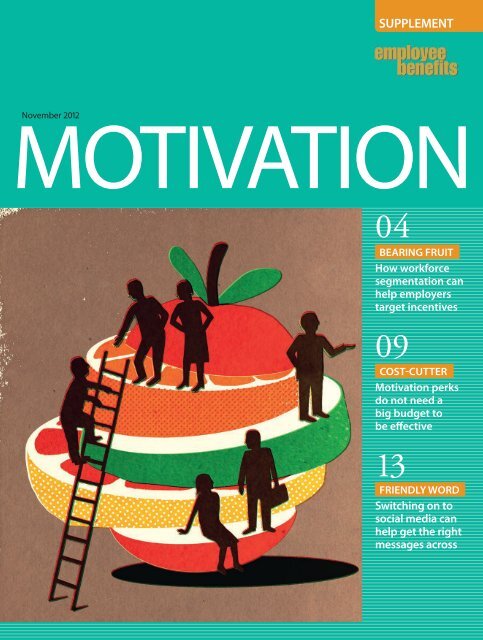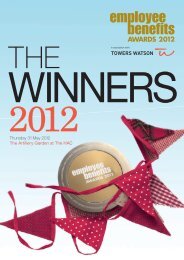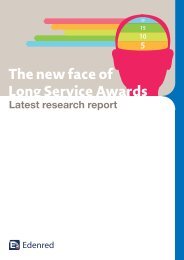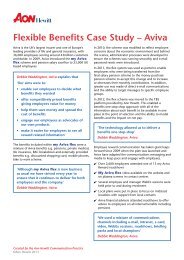Motivation report - Employee Benefits
Motivation report - Employee Benefits
Motivation report - Employee Benefits
- No tags were found...
You also want an ePaper? Increase the reach of your titles
YUMPU automatically turns print PDFs into web optimized ePapers that Google loves.
HIGH PERFORMANCE MOTIVATION 03Work gains need joint effortHigh-performance work practices could improve employee productivity, butthere are potential negative effects to deal with, says Olga Tregaskis❝<strong>Employee</strong>sneed to seea tangiblepayback fortheir effortsHigh-performance work practices (HPWP) is theterm used to refer to HR management practicesassociated with employee engagement,performance management, work organisation,skills development and learning. Increases in performancedo not necessarily come from a single HR practice, butfrom the synergies of an architecture on performancemanagement that values, motivates and rewards effort.HPWP has attracted considerable interest in recentyears because of its potential impact on an organisation’sperformance, but the link is contentious. There is evidencethat HPWP can help to improve performance, but gainsmay be achieved through intensification of work, suchas increased workload or pressure, which can have adetrimental effect on employees. So, can HPWP boostperformance without negative effects for staff?Recent case research suggests it is possible to achievea win-win scenario for employers and employees, but thisdepends on how HPWP is implemented. Certain key stepsare needed to achieve a positive outcome for all parties.First, employees need to see a tangible payback fortheir initial efforts before they are likely to offer morecommitment. So, changes in working arrangements thatyield higher performance for the organisation should bereinforced by changes in pay and reward or improvementsin working conditions. If an employee fails to see anybenefit from their extra efforts, further performanceimprovements will probably stall.Second, it is vital to secure senior managementsupport for implementing HPWP because this signals thelegitimacy of the changes to employees.Employers should also bear in mind that staff areconstantly bombarded by change initiatives, which candesensitise them to the strategic importance or value ofany programme. So, if employees are to feel motivatedto change their behaviours, they need clear signals fromsenior management that change is desirable, necessaryand will yield reward for employees, not just the employer.Managers should not assume that HPWP producesuniversally positive effects. Increases in workload and morepressure on staff are often <strong>report</strong>ed as characteristics of amove towards HPWP. However, these negative effects canbe offset by changes in how work is organised, changes inreward management, and training opportunities.Constructive dialogueConstructive dialogue between employers and employeesprovides the communication channels to monitor andsustain change and performance gains. Issue-basedemployer-employee groups have been used successfullyto support HPWP implementation. Building strong trustbetween employer and employees is critical.A final point to consider is which performance metricsto use to assess the impact of HPWP. Financial performanceis often taken as the key indicator, but this depends onfactors other than employee effort, such as marketing,accounting procedures and the economic environment.For this reason, the evidence supporting the link betweenHPWP and corporate performance can be ambiguous.To address this problem, researchers have looked atthe predictive and explanatory power of other interveningperformance factors and found good evidence of theirreliability. These may include hard measures, such asproductivity or safety, or soft measures, such as employeemotivation or job satisfaction. For line managers, HRprofessionals and project leaders, these indicators are likelyto yield the best information on performance change.So, HPWP has the potential to make an importantcontribution to an organisation’s performance. The key liesin collaborative implementation.Olga Tregaskis is professor of international human resourcemanagement, Norwich Business School, University of East Anglia.www.employeebenefits.co.uk I November 2012
04 MOTIVATION COVER STORYSlices of lifestyleEmployers that want to understand what motivates different parts of their workforce canfollow retailers’ example and adopt a segmentation strategy, says Clare BettelleySupermarket giants know every aspectof their customers’ shopping behaviour,from the products they buy totheir average spend. They then usethis data to motivate them to spend more.This is done via a savvy approach to customerprofiling known as segmentation. Customersare categorised according to certain criteria onwhich the organisation bases its business strategies,from marketing through to procurement.A simple example is a supermarket segmentingcustomers according to their weeklyspend. The process can help the store targetgroups of customers with the right promotionalliterature about certain brands accordingto their spend, with higher-value and aspirationalbrands promoted to bigger spenders,and lower-cost and value brands directed atmore modest shoppers. In a similar way,employers can use segmentation to motivatetheir workforce.Tailor benefitsSegmenting the workforce can help employerstailor their employee benefits more effectivelyto achieve certain outcomes. For example, anorganisation might offer a sales team a bonusto hit a particular profit level if it agrees withthe common assumption that sales teams arebest motivated by monetary rewards.Matthew Gregson, managing consultantat Thomsons Online <strong>Benefits</strong>, says: “Overall,we see segmentation as the next iteration ofreward and benefits. From a package perspective,it is about providing the right benefitsaccording to what people value. From a communicationsperspective, it is about makinghuge efficiency gains by providing as littleinformation as possible to get people engagedwith the programme. Put the two together and[employers] have a winning approach.”So, where can employers start? They shouldfirst identify their desired outcome. Is it to motivatestaff to hit a profit target or to promote aparticular corporate culture?Next, employers must understand whatmotivates their workforce in order to identifythe most suitable benefits to offer, rather thanmaking their own assumptions about theproducts and services that they believe will bemost effective.David HumphriesNovember 2012 I www.employeebenefits.co.uk
Supermarkets learn about their customerbase from a range of sources, including loyaltycards, such as Tesco’s Clubcard and the Nectarcard. Employers can use surveys and focusgroups to help understand what motivatestheir employees, as well as online forums.Misguided programmeStephen Mork, principal in Buck Consultants’compensation practice, says a misguidedmotivation programme is as good as having noprogramme at all. “I was working with a largeIT company in the Netherlands,” he says. “Itwas having a problem with turnover. It had apension plan it had put in to avoid that, whichwas a very rich defined benefit (DB) plan. Butafter the scheme was implemented, the [high]turnover remained.“We went in and did some employeefocus groups and discussions to find out whatemployees really wanted. Theaverage age of staff was 26 or 27.What they wanted and what theywere getting were two differentthings, which was the reason forthe [high] turnover. The companyjust assumed that if it put in apension plan it would attract andretain employees.”After holding a number offocus groups with staff, Morkquickly learned that employees were more motivatedby being able to wear jeans to work, bybeing able to get a bus pass because the officewas located outside Amsterdam, and by trainingand development, rather than by a pension.IF YOU READ NOTHING ELSE,READ THIS . . .● Avoid trying to shoehorn benefits to fitemployee segments.● Do not assume that people of the samedemographic segment will want thesame things.● Employers should be creative in the waythey communicate key messages aboutbenefits to staff.“The companyjust assumedthat if it put ina pension plan,it would attractand retain staff”Stephen Mork,Buck Consultants“The employer spent millions of euros todevelop this pension scheme and it wasn’tgetting a return for it,” he says. “It could haveinvested a fraction of the cost in developingthese programmes, that a lot of the time arevery minimal [in cost] or even free, to get moreof a return for its investment.”Once employers understand what motivatestheir workers, they can begin to decide how toapproach segmentation. Criteria to considerinclude employee age, job role and geography.However, Mork says he rarely comes acrossjob role as the basis for segmentation basedon a motivation programme, and says age ismore popular. “If the population is 50-plus, itis going to be more interested in pensions,” hesays. “For those in their 30s and 40s, it is moreabout compensation, and for 20s and below, itis more about training and development, andgetting their career on track.”The work environment is anequally important, but not necessarilyobvious, motivator for theunder-20s. Mork adds: “The mobileworkforce that we have meansthat having a workplace environmentwhere you have the freedomto work at home or wherever youare, versus having to come into aconcrete building every day, isvery important.”Geography is also an important factor,particularly for global employers, says Mork.“Employers need to look at locations, countryspecificlocations as well, to make sure rewardsmake sense to that particular country and area,and from a number of different angles, such asthe appropriateness of it. Does it fit? I often seesomebody will put in a good reward system,say in the UK, and then they try to export itglobally. When [an organisation is] in 40 countries,obviously having one reward system isnot going to fit in all those 40 countries.”Organisations also need to assess howengaged employees are with their current benefitspackage, because even the most comprehensivemotivation programme in the worldwill not be effective if staff are not engaged inthe motivational tools from the outset.In such cases, the employer’s initial requiredoutcome may be to achieve employeeViewpointMatt Duffyhead of onlinebenefits, Lorica<strong>Employee</strong> <strong>Benefits</strong>Accurate data is the key toeffective segmentationThe starting point for any segmentationstrategy should be clean and accurate data.Employers should liaise with HR and payrollto ensure they have as much relevantinformation on employees as possible.Analyse this data to identify differentsegments and populations of employees.While most employers acknowledge theobvious categories based on standarddemographic dimensions, such asgeneration, gender and ethnicity, fewrecognise that even employees of the samedemographic group can be highly diverse,with different abilities, work styles, andpreferences and motivations to work.Effective segmentation involves anemployer creating its own groups andcategories, but then going a step further tofind new populations within those groups.This enables it to offer choices tailored tothese segments with respect to benefits,compensation, training and development.Shoehorning existing benefits to fitdifferent employee segments simply doesnot work. Employers must find new andappropriate benefits that genuinely matchtheir employee populations. Focusing anddefining benefits in this way can have a bigimpact on take-up and perceived value.The process is not just about segmentinga workforce, but also about segmentingcommunications. To increase take-up ofbenefits, employers need to identify themethods and frequencies that resonate witheach group. Also keep all communicationssimple, concise and easily digestible.Read more industry opinion at:bit.ly/PxLCwVwww.employeebenefits.co.uk I November 2012
06 MOTIVATION COVER STORYCASE STUDYSykes ensures staff connect with right incentivesSegmentation is key to therecognition and incentiveprogramme launched by SykesGlobal Services in May.The call centre servicesfirm’s programme, SykesPride,was designed to improverecognition among its 650Edinburgh-based staff througha range of award schemes.These include key performanceindicator (KPI) awards for staffwho hit their assigned KPIs,ad-hoc awards for those whogo the extra mile in their role,and long-service awards.A dedicated IT platform,provided with the programmepackage from AYMTM, enablesmanagers to set targets andmonitor employees’ progress,thanks to the segmentationengagement with their benefits packagebefore even considering how best to use it tomotivate certain desired behaviours.But Yannis Georgellis, professor of leadership,human resources management andorganisation at the University of Kingston, saysprocess AYMTM undertookwith Sykes at the outset.Alice Wilson, operationalbusiness support manager,Western Europe, Middle Eastand Africa at Sykes, says: “Itwas segmented on the level ofthe person, approval authorityand department. There is awide range of KPIs, which aredepartment specific. Forexample, the KPI requirementsfor an inbound team aredifferent from those for atechnical support team.“Administration andsupport staff are awarded forgoing the extra mile andtaking on extra responsibilities(fire wardens, for example)while inbound call-focusedstaff have activity-driven KPIs.“Managers can view andapprove the awards,nominations andcorresponding data that arerelevant to their team and theirspecific roles, preventingemployees being bombardedwith irrelevant information.This enables staff andmanagers to understand thecore values, businessobjectives and their ownperformance against targets."employers can help themselves by ensuringthat they employ people that they can motivatein the first place.“Devise recruitment methods that enableemployers to self-select the right people forthe right job,” he says. “For example, if the jobis about offering a service to society in a nonprofitorganisation, such as a university, thenemployers need to attract individuals who aresocially motivated.“If they appoint the wrong people for thewrong job, then the quality of the match[between the employee and the role] will bevery low and therefore productivity will be verypoor. The only way [for employers] to deal withthis is to either get rid of the people who don’tfit their values or try to train them. The recruitmentprocess is critical.”Thomsons’ Gregson adds: “All of that said,segmentation can be only one part of thethinking around the right package of benefits.Organisational drivers, such as reducing risk orremaining competitive, are also key.” ■Read more on staff motivation at:bit.ly/R71jIoCREATING STAFF LOYALTYTo see how we can help you create staff loyalty:Phone: 0845 601 6699 Email: wickesforbusiness@wickes.co.ukNovember 2012 I www.employeebenefits.co.uk
Help your staff findtheir silver liningWith us, you canA little financial education can be all you need to help yourpeople harness the full potential of their benefits package.We help individuals throughout their career to valuetheir benefits package through jargon free, engagingcommunications; inspiring them to make their rewardswork harder for a brighter future.Boost moraleIncrease motivationAttract and retain the best peopleClose Brothers has been helping the employees of someof the largest and best known UK employers with theseissues for over 40 years.Find out how we can help you atwww.close-events.comor call 0800 028 8950Close Brothers Asset Management is a trading name of Close AssetManagement Limited and is part of Close Brothers Group plc. CloseAsset Management Limited is registered in England and Walesand authorised and regulated by the Financial Services Authority.Registered number: 01644127. Registered office: 10 Crown Place,London EC2A 4FT. VAT registration number: 245 5013 86.© Copyright Close Asset Management Limited 2012CBAM 499 21/06/12 v2
more choice,more funDon’t struggle for ideas this Christmas.Be confi dent that you are giving your colleagues and customers something they will love.The UK’s leading multi-store gift voucher since 1980, bonusbond gift vouchers can be spent inover 25,000 outlets nationwide and it’s not just about high street shopping! They can be usedin restaurants, to book a holiday, a night away, or for that once in a lifetime experience andso much more. Let them choose.Enjoy spending at Argos, Boots, Comet, Debenhams, HMV, Homebase, John Lewis,River Island, Waterstones and many more of the UK’s favourite retailers...To buy bonusbond gift vouchers and tosee where you can spend them, visit:www.bonusbond.comcall us on0844 800 6435
SOCIAL MEDIA MOTIVATION 13CommunityinvolvementEmployers are switching on to social media as a tool fordelivering employee recognition, but the strategy must becarefully controlled, says Jennifer PatersonThinkstockRecognising and applauding thesuccesses of our friends and family hasbeen made easier by the plethora ofsocial media tools in existence. We cancongratulate friends through Facebook, shareanecdotes of a job well done on Twitter andtrack their career progress through LinkedIn.But what role does social media have when itcomes to workplace recognition programmes?Employers are increasingly using suchmedia as an internal communications tool,with online billboards such as Chatter, Jiveand Yammer proving popular platforms forcommunicating with employees.Yammer, part of Microsoft, is used byIF YOU READ NOTHING ELSE,READ THIS . . .● Employers are increasingly using socialmedia as an internal communications tool.● Popular sites include online billboards,such as Chatter, Jive and Yammer.● The low-cost, instantaneous natureof social media-based recognitionprogrammes makes them attractivetools for employers to use, particularlyduring the economic downturn.200,000 organisations worldwide, includingDeloitte, O2 and Shell. It is designed forcompany collaboration, file sharing, knowledgeexchange and team communication.Grant Beckett, vice-president of productat Globoforce, says: “Employers are creatingcommunities of interest around a project,an organisational structure or a theme todrive the cross-pollination of ideas andinformation across the organisation. These feellike a GooglePlus, where an individual joinscommunities and invites others to join them.”Community billboardsEmployers are increasingly using thesecommunity-based billboards to build andpromote recognition programmes, says ColinHodgson, sales director at Edenred. “Approvednominations are increasingly presentedand communicated via blogs or billboards,”he says. “This enables employees to go andcongratulate their colleagues through thesame blog or billboard.”A major benefit of a community-basedrecognition programme is the greaterdemocracy achieved by all-employee access,increasing the likelihood of engagement.Beckett says: “Making it social broadens thefabric of all the recognition moments withinthe organisation. It is not held by a select fewmanagers who can nominate people or heldTools of the trade:How the socialmedia sites workA social utility thatconnects users with others whowork, study and live around them.Users can followfriends, colleagues, favouritecelebrities and breaking news, andupdate their own page with tweetsof up to 140 characters.A tool to manage users’professional identity and build andengage with people in theirprofessional network.A tool for organisationsto exchange questions and answersacross departments, geographies,content and business applications.by a committee choosing the employee of themonth, but really making it more of a culturewithin the organisation.”One of the challenges of this approachwww.employeebenefits.co.uk I November 2012
14 MOTIVATION SOCIAL MEDIAis ensuring that the recognitionprogramme is not broadcast outsidethe organisation. Andrew Johnson,director general of the UK GiftVoucher Association (UKGVA), says:“Clearly, there are some great toolsto use for employee communication,but employers should be clear aboutthat line between work and home.”Beckett advises employers to keeptheir recognition programmes withinthe organisation’s firewall. “Someproviders boast that being able topost it to external social media is apositive thing,” he says. “But whathappens, especially on LinkedIn, isthat they are telling their competitorswho their stars are and why they arebeing recognised.”So, what are the rules whenchoosing social media sites?Consumer social media, such asFacebook, LinkedIn and Twitter, are certainlymost popular with younger, tech-savvy staff.But employers should not become preoccupiedwith site choice. Niall Cook, co-founderand principal at social media consultancySociagility, says: “It’s not about choosingplatforms like Twitter or Facebook, but aboutemploying the underlying technologies in aninternal environment. Wikis, micro-bloggingOrganisations’ attitudesto using social media inrecognition programmes40%26%11%11%11%11%Would like to investigate it, but it is not a priorityCurrently use it and plan to do moreUse it and are evaluating it to see if they should continueHave tested it and found it did not workDo not think social media has a role in recognitionOtherResearch conducted by Edenred inSeptember 2012 exclusively for<strong>Employee</strong> <strong>Benefits</strong>.and sharing tools all have their place as partof a joined-up strategy, and it is a case ofselecting those that fit with the culture of theorganisation, the capabilities and attitudes ofemployees, and the objectives of the business.”Of course, not all employers will be readyfor such technological advances. Globoforce’sBeckett says: “I was talking to a conservative,UK-based bank, and it was very interested in it,but was not sure the workforce wasquite ready for it. In other industries,it is only a matter of time before it isfull-scale.”Cook adds: “It’s very much a caseof aiming before firing. Employersshould be prepared to undertakeresearch and not expect socialmedia to be a panacea to their ills.”Nevertheless, the low-cost,instantaneous nature of socialmedia-based recognition schemes,together with the ability to engagestaff individually, makes themattractive for employers to useduring the downturn. The use ofsocial media also signals a moveaway from traditional employeerecognition schemes.“Organisations are becomingstrategic in the way they deliverrecognition,” says Edenred’sHodgson. “It is less about the local manager, abottle of wine or a box of chocolates, and moreabout identifying the impact on the individual,on the culture and atmosphere within thebusiness, and on overall performance.” ■Read also When employers should use social media at:bit.ly/Tt9GMNCASE STUDYVirgin Media employees have a lot to shout aboutVirgin Media has evolved itsrecognition programme, Shout,from a paper-based scheme to asocial media-based model in linewith the organisation’s focus ontechnology in recent years.The scheme started at VirginMobile, where it was managed byan external provider. Staff filled in aform, known as a ‘Shout’, andhanded it to a colleague, whopinned it to the back of their desk.When Virgin Mobile wasrebranded to Virgin Media inFebruary 2007, the recognitionprogramme was added to thecompany intranet, and in 2009employee profile pages wereintroduced, like those used onFacebook, on which the Shoutscould be displayed.Emily Scammell, engagementand employee insight manager atVirgin Media, says: “Bringing [theprogramme] in to be part of eachemployee’s profile makes it a moresociable process. [<strong>Employee</strong>s] maynot be looking for someone’sShouts, but they will see how theyhave been recognised. There is alsoa live feed of Shouts displayed onthe front page of our intranet.”<strong>Employee</strong>s’ profile pages alsodisplay their contact details, jobrole and team, a profile image, andan ‘About Me’ tab, where staff cangive details about when theyjoined the company, their hobbiesand their favourite film.Shouts can be downloaded fromprofile pages for use in employees’appraisals with their manager,although managers receive anemail each time one of their teamreceives a Shout. Managers areencouraged to recognise Shouts inteam meetings.Virgin’s recognition programmeis open to almost 18,000employees, and an average of 543Shouts are registered each day and19,000 each month.November 2012 I www.employeebenefits.co.uk
A TRULYWIN-WIN EMPLOYEEBENEFITA DELICIOUS COST NEUTRALEMPLOYEE BENEFITAs Gourmet Society members your employees can enjoy up to50% off meals at thousands of restaurants across the UK and IrelandGourmetSocietySpin plate to make selectionGOURMETSOCIETY.CO.UKGourmetSocietyMembership CardMember Services: 0845 257 4477Contact Jessica to get more information and the best rates:jessica.steele@gourmetsociety.co.uk | 0800 043 1978 | www.gourmetsociety.co.uk













